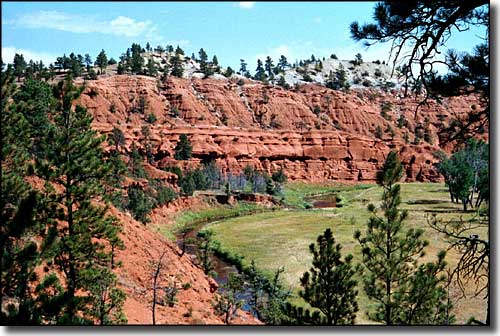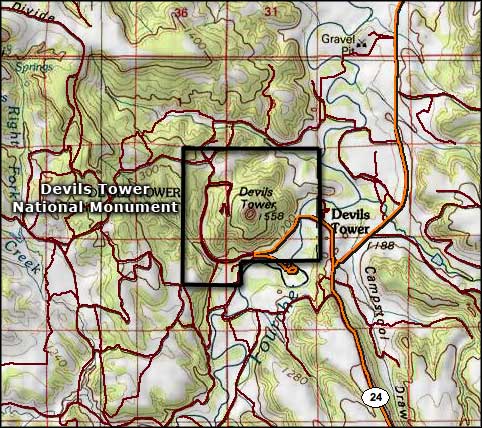
Devils Tower National Monument

Devils Tower

Made famous in the 1977 movie Close Encounters of the Third Kind, Devils Tower is a monolithic igneous intrusion (also known as a "volcanic neck") in the northwestern area of the Black Hills (northeastern Wyoming). This solid chunk of granite rises 1,267 feet straight up above the surrounding terrain. The 1,347 acres surrounding the monolith were designated as Devils Tower National Monument on September 4, 1906 by President Theodore Roosevelt.
Most of the landscape surrounding Devils Tower is composed of different layers of sedimentary rock. Lowest is a red sandstone and maroon siltstone interbedded with shale, the whole known as the Spearfish Formation, laid down between 225 and 195 million years ago. Above that is the Gypsum Spring Formation, a thin band of white gypsum deposited between 195 and 136 million years ago during the Jurassic period. Above the Gypsum Spring Formation are layers of gray-green shales interbedded with fine-grained sandstones, limestones and the odd thin bed of red mudstone, all deposited during eras of climate and sea level changes. This composition is a part of the Sundance Formation known as the Stockade Beaver member. Above that is another part of the Sundance Formation known as the Hulett Sandstone member. The Hulett Sandstone is that fine-grained yellow sandstone that forms the almost vertical cliffs that surround the base of the tower itself.
When the Laramide Orogeny pushed up the Ancestral Rocky Mountains and the Black Hills during the Tertiary period some 65 million years ago, magma was pushed up through the crust of the Earth and voila: the basic rock of Devils Tower was put in place. However, that beautiful chunk of rock didn't protrude above ground until the surrounding layers of sedimentary rock were eroded away over the last 65 million years. Devils Tower itself is not immune to the forces of erosion: the large piles of scree at the monolith's foot are evidence that the tower was once much wider than it is today.
About 1% of Devils Tower National Monument's 400,000 annual visitors come to climb the tower each year. Today, there are many documented and established climbing routes on every face of the tower, but the most commonly used route is the Durrance Route, first established in 1938. The difficulties encountered along these various routes vary from the relatively easy to some of the hardest big-face routes in the world. All climbers are required to register with a park ranger before climbing and after returning from a climb, whether they were successful or not.
Because several Native American tribes (the Kiowa, Cheyenne and Lakota Sioux in particular) hold the monolith sacred, climbing on it is a contentious subject. Presently, there is a voluntary ban on climbing during the month of June while the tribes are conducting ceremonies around the monument. About 85% of potential climbers honor that voluntary ban but there are some who don't, and there are some (in conjunction with the Mountain States Legal Foundation) who have even sued the National Park Service while trying to enforce the constitutional ban on government entanglement with religion.

The Spearfish Formation along the Belle Fourche River in the area of Devils Tower

The area of Devils Tower National Monument
